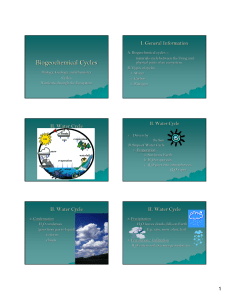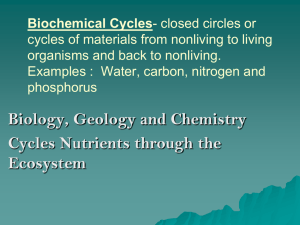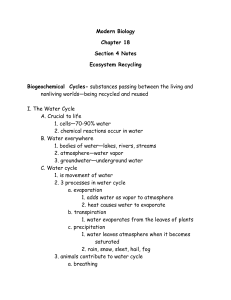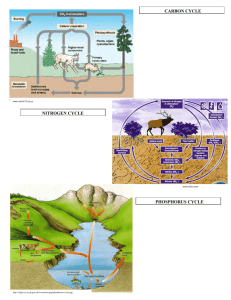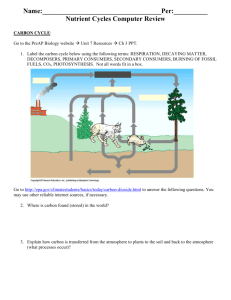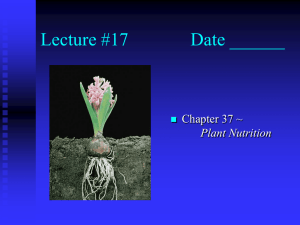Biogeochemical Cycles Biology, Geology and Chemistry Cycle Nutrients through the Ecosystem
advertisement
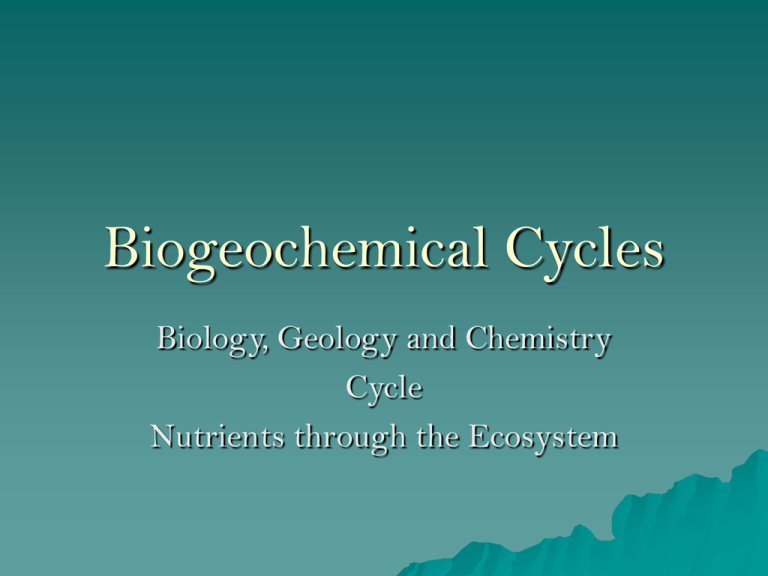
Biogeochemical Cycles Biology, Geology and Chemistry Cycle Nutrients through the Ecosystem I. General Information A. Biogeochemical cycles = materials cycle between the living and physical parts of an ecosystem B. Types of cycles 1. Water 2. Carbon 3. Nitrogen II. Water Cycle II. Water Cycle A. Driven by the Sun B. Steps of Water Cycle 1. Evaporation – a. Sun heats Earth b. H2O evaporates c. H2O goes into atmosphere as H2O vapor II. Water Cycle 2. Condensation H2O condenses (goes from gas to liquid) to form clouds II. Water Cycle 3. Precipitation H2O leaves clouds, falls on Earth E.g. rain, snow, sleet, hail 4. Percolation / Infiltration H2O enters soil, becomes groundwater II. Water Cycle 5. Run–off Some H2O moves on surface to rivers, lakes & oceans 6. Transpiration H2O released from plant leaves, returns to atmosphere II. Water Cycle C. Where is the H2O on Earth? 1. Oceans 97.2% 2. Glaciers 2.15% 3. Lakes 0.009% 4. Soil 0.005% 5. Atmosphere 0.001% 6. Streams II. Water Cycle III. Carbon Cycle III. Carbon Cycle A. How does carbon enter the living part of the cycle? 1. Photosynthesis Plants, algae, & cyanobacteria use CO2 to make organic compounds (sugars) 2. Nutrients move C through trophic levels Consumers move organic compounds III. Carbon Cycle B. How does carbon get back into the physical part of the cycle? 1. Respiration O2 used to break down sugars, CO2 released III. Carbon Cycle 2. Combustion Fossil fuels & wood burned CO (carbon monoxide) released to atmosphere Factory & Auto emissions release CO to atmosphere III. Carbon Cycle 3. Erosion CaCO2 from shells returned to system as sediment Shelled organisms die Sediment returns C to ecosystem by erosion (wind & water) III. Carbon Cycle 5. Decomposition of waste and dead materials Some dead organisms become fossil fuels Some dead organisms and waste decay, returning nutrients to the soil III. Carbon Cycle IV. Nitrogen Cycle IV. Nitrogen Cycle A. General information 1. N needed to make proteins Proteins = large molecules that perform almost all of living organisms’ vital f(x)s (functions) IV. Nitrogen Cycle 2. N hard to convert into a form usable by plants 3. Most steps of N cycle occur in the soil 4. Bacteria very important to the N cycle IV. Nitrogen Cycle B. Steps of the N cycle 1. Nitrogen fixation Bacteria work with legumes (peas, beans, peanuts) to take N2 from atmosphere, put it into the soil IV. Nitrogen Cycle 2.Ammonification Animals & plants deposit nitrogenous waste Decomposers (bacteria & fungi) convert organic N (proteins) to ammonia (NH3) IV. Nitrogen Cycle 3. Nitrification Another kind of bacteria convert ammonia (NH3) → to ammonium to nitrites (NO2-) & nitrates (NO3-) NH3 → NH4 + → NO2- + NO3- IV. Nitrogen Cycle 4. Denitrification Another kind of bacteria convert nitrites and nitrates to nitrogen gas NO2- + NO3- → N2 IV. Nitrogen Cycle
